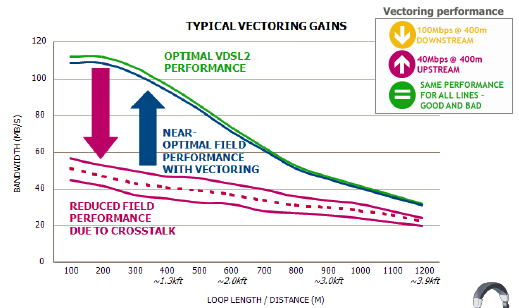
Telecom engineers continue to amaze.
With only the primitive transistors of 1960 they encoded voice for digital transmission via channel banks and T-1 circuits. In short order carrier networks, both transmission and switching, became all-digital. That left the copper local loops as the remaining analog portion of the PSTN, providing plain old telephone service (POTS) to traditional phones.
When ISDN attempted to extend digital transmission to every customer device the electronics of that era limited the capacity on most pairs to 2 Mbit/s or less--more often 160 kbit/s for a maximum-length residential line in a standard serving area around a central office. That isn't enough for today's World Wide Web and streaming video (which is why ISDN mostly faded away).
So the folks in the back room have sent out another level of capability. Building on decades of Moore's Law, R&D steadily improved the electronics for Digital Subscriber Line (DSL) technology to squeeze more and more bandwidth from the copper. Advances came in several forms:
- Many carrier frequencies on a pair. Orthogonal Frequency Division Multiplexing (OFDM) put hundreds of virtual modems in parallel, each on its own carrier frequency, over one wire pair.
- More efficient coding. How a bit appears on the wire changed from simple on/off signals (T-1) to 4-level signals (ISDN), to adding a phase change (quadrature coding in modems). The number of bits per baud (how many bits each digital symbol conveys) went from 1 to 64 and may go higher.
- Improved signal-to-noise (SNR) ratio. Echo canceling, first applied to voice, does wonders for data too.
- Interference canceling. The latest is highly adaptive "vectoring" among all the pairs in a cable.
The term vectoring isn't instantly clear, but it's sometimes compared to noise-canceling headphones that actively counter unwanted sounds. Each wire pair in a cable, or at least in a binder group, in effect monitors all the other pairs for potential interference. When a signal on an one pair affects the signal on another pair the result is crosstalk, which makes it harder for the receiver at the customer end to read the data correctly.
To implement vectoring, a controller in the central office DSL Access Multiplexer (DSLAM) monitors the signals on all pairs in the local loops and calculates how they affect each other. The controller adjusts the transmitted signal on each pair to counteract offending interference from all the other pairs. Yes, that is computationally intense. Cutting crosstalk means that the signal received by the customer is "cleaner" and more easily understood. That in turn means the signal can be weaker yet still work reliably which extends the reach and/or raises throughput on each pair.
As true for all DSL, the product of 'bit/sec speed' times 'cable distance' is roughly a constant that is determined by the Signal to Noise Ratio (SNR). Less noise, including crosstalk, means higher speeds and/or longer reach at a given speed. Recently Alcatel-Lucent briefed consultants on some new equipment that applies vectoring to local loops. The following chart reports their tests that show more than double the throughput compared to previous DSL methods.
Throughput of 100 Mbit/s over DSL at 1000 ft and 50 Mbit/s at half a mile should get existing copper loops serious consideration when customers demand more capacity. They will: for streaming video on demand, video conferencing, and other unified communications functions.
But it gets better, at least for the carriers, because progress in speed x distance comes with simpler management. Most of the DSLAM configuration downloads from a central server. The crosstalk canceling functions (vectoring) are dynamic so need no setup.
Next step will be dealing with random external noise from electric motors, switches, welding, etc. This "impulse noise" is the subject of a recommendation, G.imp, in development at the International Telecommunications Union.
The sum of these improvements will give customers more capacity for new uses. People will get the speeds and service qualities they want. Under central control, a Software Defined Network (SDN) will use the increased bandwidth, or what portion the customer has arranged to pay for, to set up services requested by software applications or devices like IP telephones.
Don't hold your breath for this kind of activity on your lines, but if you breathe normally for a few years you may just have it.














If the facts and my understanding are in line, you just explained how the existing copper facilities can be utilized to handle the increase in bandwidth demand at the bottle-neck (end-user), saving countless amounts of time to market via long interval fiber builds as well as the Cap-X related to bringing high band width to customers outside of the "fiber-loop".
Please correct me if I am wrong but this may be thought of as one of the most efficient and beneficial local loop "recycling projects" projects ever?
Yes, vectoring and other techniques (impulse noise protection, etc.) increase the monetary value of the existing copper infrastructure by increasing the digital throughput capacity. It could mean that the higher value will justify (economically) preserving the twisted pairs in future. And if they are there for DSL, why not use them for analog voice as well? Some carriers might slow their migration to "all IP" networking for voice.